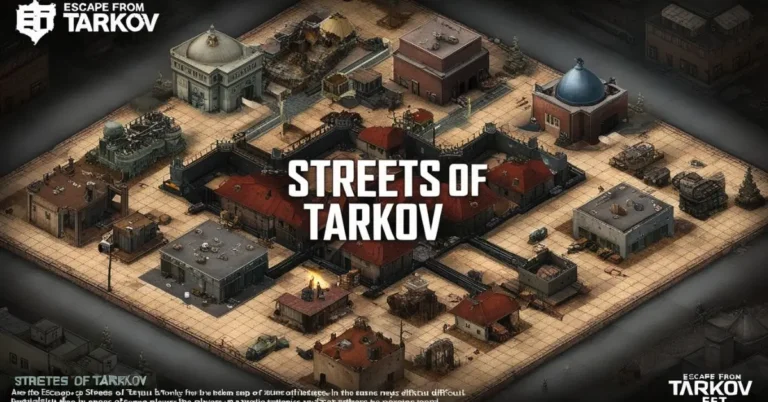In the unforgiving, hyper-realistic world of Escape from Tarkov, maps are more than just battlefields; they are narratives. They tell stories of conflict, desperation, and a world gone mad. No map in the game embodies this narrative density and sheer, overwhelming scale quite like Streets of Tarkov. Since its release, it has stood as both the crown jewel and the most daunting challenge in Battlestate Games’ ambitious project. It is a map that doesn’t just ask for your attention—it demands your immersion, punishes your mistakes, and rewards your patience like no other.
At its core, Streets of Tarkov is a masterclass in environmental storytelling. Unlike the more structured layouts of factories or woods, Streets presents a sprawling, open-ended urban jungle, a hauntingly familiar cityscape frozen in a moment of catastrophic collapse. The air is thick with tension, punctuated not only by the distant cracks of sniper fire but by the eerie silence of abandoned cars, ransacked apartments, and toppled street signs. You navigate through the husk of a once-vibrant city: a bombed-out cinema, a looted convenience store, a multi-story hotel with rooms telling a hundred silent stories of interrupted lives. This isn’t just a backdrop; it’s a character in itself. The sheer verticality and density force players to constantly consider a threat from every window, every balcony, every dark alleyway. The sound design, a hallmark of Tarkov’s brutal realism, is at its most complex here. The crunch of glass underfoot, the echo of a footstep in an empty parking garage, and the distorted murmur of a distant Scav conversation create an audio landscape that is as informative as it is terrifying.
From a gameplay perspective, Streets is a beast of a different nature. It is, by a significant margin, the largest map in the game, and its complexity can be utterly paralyzing for newcomers. The initial experience for many is one of pure sensory overload. Where maps like Customs or Interchange have clear lanes and landmarks, Streets is a labyrinthine network of interconnected streets, buildings, and underground passages. Getting lost is not just a possibility; it is a guarantee. This complexity, however, is what makes mastery so rewarding. The map is loosely divided into key zones, each with its own flavor and strategic value.
The Lexos business complex and the Crane Yard offer intense, close-quarters combat opportunities and high-tier loot, often drawing in geared players and squads for brutal firefights. The Concordia apartment buildings provide a terrifying playground for indoor ambushes and room-to-room clearing, where sound is your only true ally. Meanwhile, the outskirts and less-traveled streets can be a haven for scavengers and players looking to avoid the main chaos, though nowhere is ever truly safe.
This brings us to the most defining and infamous aspect of Streets of Tarkov: its performance demands. Dubbed a “slideshow” by many upon its initial launch, the map pushed PCs to their absolute limits and beyond. The incredible detail, the number of dynamic objects, the sheer scale, and the potential for 15+ player PMC raids combined with countless Scavs created a technical hurdle that Battlestate Games is still diligently optimizing. For a long time, playing Streets was a gamble—a potential for incredible gameplay moments locked behind stuttering frames and multi-minute load times. This technical challenge became an intrinsic part of the map’s identity, a barrier to entry that separated those with top-tier rigs from the rest. While significant improvements have been made, it remains the most demanding location in Tarkov, a testament to the developers’ ambitious, albeit punishing, vision.
Strategically, success on Streets requires a complete shift in mindset. The “W-key” mentality of rushing and aggression that can work on smaller maps is a fast track to the death screen here. Survival hinges on a few key principles:
- Knowledge is Everything: Learning the map is your primary objective. Knowing which buildings connect, where the scav spawns are, the names of key landmarks for callouts, and the numerous extraction points is non-negotiable. Off-raid study with a map open is as important as the raid itself.
- Sound and Situational Awareness: With so many vertical layers and indoor spaces, pinpointing sound is your greatest weapon. Moving slowly, listening for footfalls above or below you, and understanding how sound travels through the concrete cannelloni of the city can give you a crucial advantage.
- Pace Management: Knowing when to sprint across an open street and when to creep silently through a dark office building is the rhythm of Streets. There is a time for lightning-fast rotations and a time for absolute, patient stillness.
- Scav Play: The Scav cooldown on Streets is notably shorter, making it an excellent tool for learning the map’s layout and loot spawns with significantly less risk. A successful Scav run can fund your PMC’s forays into the urban heart of darkness.
For the seasoned Tarkov veteran, Streets of Tarkov represents the ultimate endgame. It is home to some of the best loot in the game, from high-value tech items in the Lexos offices to rare barter goods in the apartments. It hosts unique bosses like the ruthless Kollontay gang, and its quests are some of the most challenging and rewarding. It is a map that truly has something for every playstyle, from the stealthy rat to the chad-led squad.
In conclusion, Streets of Tarkov is more than just a map; it is the fullest realization of Tarkov’s core promise. It is a brutal, immersive, and deeply complex urban simulator that perfectly captures the atmosphere of a city in its death throes. It is frustrating, awe-inspiring, punishing, and magnificent, often all within the same raid. It demands respect, preparation, and a powerful computer, but in return, it offers an unparalleled gaming experience. To conquer the Streets is to understand Tarkov itself—a testament to perseverance in a world designed to break you.

